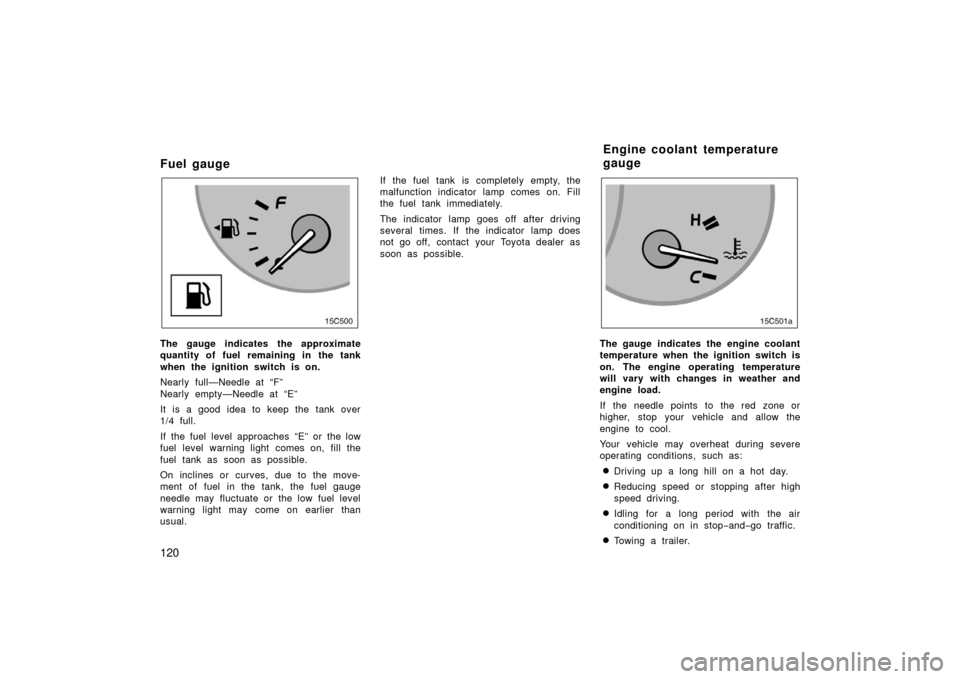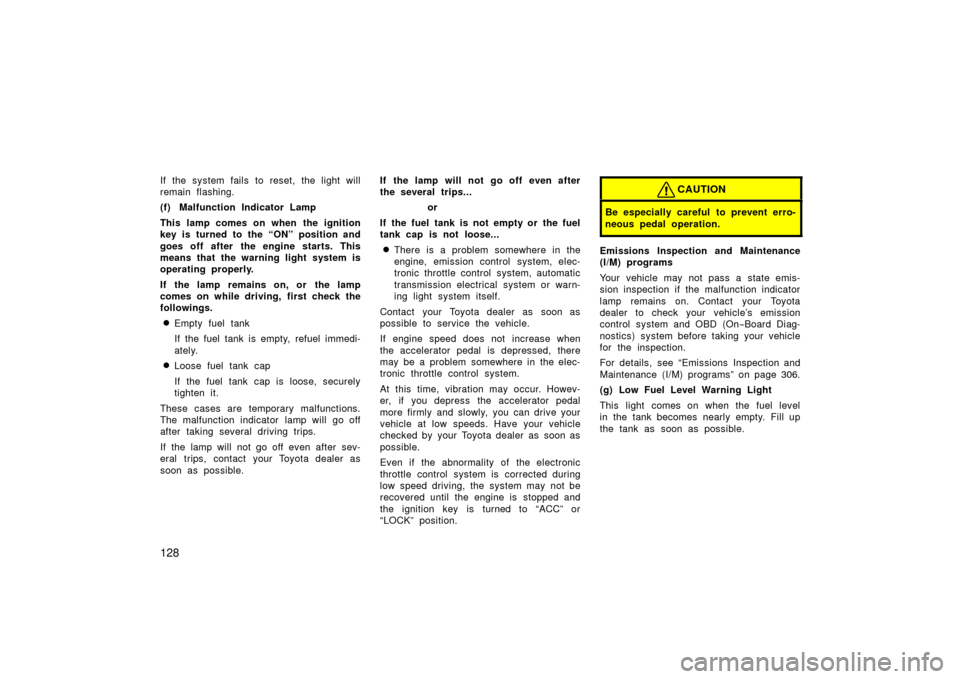Page 41 of 364
31
12C006b
2. To remove the fuel tank cap, turn
the cap slowly counterclockwise,
then pause slightly before removing
it. After removing the cap, hang it
on the cap hanger.
It is not unusual to hear a slight swoosh
when the cap is opened. When installing,
turn the cap clockwise till you hear a
click.
If the cap is not tightened securely, the
malfunction indicator lamp comes on.
Make sure the cap is tightened securely.
CAUTION
�Make sure the cap is installed se-
curely to prevent fuel sp illage in
the event of an accident.
�Use only a genuine Toyota fuel tank
cap for replacement. It is designed
to regulate fuel tank pressure.
Electric moon roof
Sliding operation
Tilting operation
Page 129 of 364
11 9
OPERATION OF INSTRUMENTS AND
CONTROLS
Gauges, Meters and Service reminder indicators
Fuel gauge120
. . . . . . . . . . . . . . . . . . . . . . . . . . . . . . . . . . . . .\
. . . . . . . . . . .
Engine coolant temperature gauge 120
. . . . . . . . . . . . . . . . . . . . . . . . . . .
Engine oil pressure gauge 121
. . . . . . . . . . . . . . . . . . . . . . . . . . . . . . . . . . .
Vo ltme te r 122
. . . . . . . . . . . . . . . . . . . . . . . . . . . . . . . . . . . . \
. . . . . . . . . . . . . .
Tachometer 122
. . . . . . . . . . . . . . . . . . . . . . . . . . . . . . . . . . . . \
. . . . . . . . . . . .
Odometer and two trip meters 123
. . . . . . . . . . . . . . . . . . . . . . . . . . . . . . . .
Service reminder indicators and warning buzzers 124
. . . . . . . . . . . . . .
Trip information display 132
. . . . . . . . . . . . . . . . . . . . . . . . . . . . . . . . . . . . \
. .
SECTION 1� 6
Page 130 of 364

120
Fuel gauge
15C004
The gauge indicates the approximate
quantity of fuel remaining in the tank
when the ignition switch is on.
Nearly full—Needle at “F”
Nearly empty—Needle at “E”
It is a good idea to keep the tank over
1/4 full.
If the fuel level approaches “E” or the low
fuel level warning light comes on, fill the
fuel tank as soon as possible.
On inclines or curves, due to the move-
ment of fuel in the tank, the fuel gauge
needle may fluctuate or the low fuel level
warning light may come on earlier than
usual.If the fuel tank is completely empty, the
malfunction indicator lamp comes on. Fill
the fuel tank immediately.
The indicator lamp goes off after driving
several times. If the indicator lamp does
not go off, contact your Toyota dealer as
soon as possible.The gauge indicates the engine coolant
temperature when the ignition switch is
on. The engine operating temperature
will vary with changes in weather and
engine load.
If the needle points to the red zone or
higher, stop your vehicle and allow the
engine to cool.
Your vehicle may overheat during severe
operating conditions, such as:
�Driving up a long hill on a hot day.
�Reducing speed or stopping after high
speed driving.
�Idling for a long period with the air
conditioning on in stop
−and− go traffic.
�Towing a trailer.
Engine coolant temperature
gauge
Page 132 of 364
122
Vo l t m e t e r
The voltmeter tells whether the battery
is charged or discharged. Check it
while the engine is running—the needle
should always indicate as shown above.
If the needle reads below or above the
normal range while the engine is running,
it indicates the charging system needs im-
mediate repair.
However, it is normal for the needle to
drop below the normal range during en-
gine starting.
Tachometer
The tachometer indicates engine speed
in thousands of rpm (revolutions per
minute). Use it while driving to prevent
engine over-revving.
Driving with the engine running too fast
causes excessive engine wear and poor
fuel economy. Remember, in most cases
the slower the engine speed, the greater
the fuel economy.
NOTICE
Do not let the indicator needle get
into the red zone. This may cause
severe engine damage.
Page 133 of 364
123
Odometer and two trip meters
This meter displays the odometer and
two trip meters.1. Odometer—Shows the total distance the vehicle has been driven.
2. Two trip meters—Show two different distances independently driven since
the last time each trip meter was set
to zero.
You can use one trip meter to calculate
the fuel economy and the other to
measure the distance on each trip. All
trip meter data is cancelled if the elec-
trical power source is disconnected. 3. Trip meter reset knob—Resets the two
trip meters to zero, and also change
the meter display.
To change the meter display, quickly
push and release the knob. The meter
display changes in the order from the
odometer to trip meter A to trip meter
B, then back to the odometer each
time you push.
To reset the trip meter A to zero, dis-
play the meter A reading, then push
and hold the knob until the meter is
set to zero. The same process can be
applied for resetting the trip meter B.
Page 138 of 364

128
If the system fails to reset, the light will
remain flashing.
(f) Malfunction Indicator Lamp
This lamp comes on when the ignition
key is turned to the “ON” position and
goes off after the engine starts. This
means that the warning light system is
operating properly.
If the lamp remains on, or the lamp
comes on while driving, first check the
followings.
�Empty fuel tank
If the fuel tank is empty, refuel immedi-
ately.
�Loose fuel tank cap
If the fuel tank cap is loose, securely
tighten it.
These cases are temporary malfunctions.
The malfunction indicator lamp will go off
after taking several driving trips.
If the lamp will not go off even after sev-
eral trips, contact your Toyota dealer as
soon as possible. If the lamp will not go off even after
the several trips...
or
If the fuel tank is not empty or the fuel
tank cap is not loose...
�There is a problem somewhere in the
engine, emission control system, elec-
tronic throttle control system, automatic
transmission electrical system or warn-
ing light system itself.
Contact your Toyota dealer as soon as
possible to service the vehicle.
If engine speed does not increase when
the accelerator pedal is depressed, there
may be a problem somewhere in the elec-
tronic throttle control system.
At this time, vibration may occur. Howev-
er, if you depress the accelerator pedal
more firmly and slowly, you can drive your
vehicle at low speeds. Have your vehicle
checked by your Toyota dealer as soon as
possible.
Even if the abnormality of the electronic
throttle control system is corrected during
low speed driving, the system may not be
recovered until the engine is stopped and
the ignition key is turned to “ACC” or
“LOCK” position.
CAUTION
Be especially careful to prevent erro-
neous pedal operation.
Emissions Inspection and Maintenance
(I/M) programs
Your vehicle may not pass a state emis-
sion inspection if the malfunction indicator
lamp remains on. Contact your Toyota
dealer to check your vehicle’s emission
control system and OBD (On −Board Diag-
nostics) system before taking your vehicle
for the inspection.
For details, see “Emissions Inspection and
Maintenance (I/M) programs” on page 306.
(g) Low Fuel Level Warning Light
This light comes on when the fuel level
in the tank becomes nearly empty. Fill up
the tank as soon as possible.
Page 141 of 364

131
(n) Vehicle Stability Control System andActive Traction Control System
Warning Light
This light warns that there is a problem
somewhere in the vehicle stability control
system and/or active traction control sys-
tem.
If the “VSC/TRAC” warning light and “VSC
OFF” indicator light come on, have your
vehicle checked by Toyota dealer as soon
as possible. However, it is no problem
that the “VSC/TRAC” warning light comes
on when the brake actuator temperature
becomes high. (For details, see “Active
traction control system” on page 144.)
The lights will come on with the ignition
key turned to “ON”, and will go off after
a few seconds.
The lights may come on for 60 seconds
after the ignition key is turned to “ON”
position. It is normal if they go out after
a whi l e.
Depressing the brake pedal repeatedly
may turn on the lights. it is normal if they
go out after a few seconds. When the “VSC/TRAC” warning light and
“VSC OFF” indicator light come on, the
vehicle stability control system and/or ac-
tive traction control system are not operat-
ing, but there is no problem if you contin-
ue to drive.
(o) Key Reminder Buzzer
This buzzer acts as a reminder to remove
the key when you open the driver’s door
with the ignition key in the “ACC” or
“LOCK” position.
CHECKING SERVICE REMINDER INDICA-
TORS (except the low fuel level warning
light)
1. Apply the parking brake.
2. Open one of the side doors or back door.
The open door warning light should
come on.
3. Close the door. The open door warning light should go
off. 4. Place the four
−wheel drive control lever
in “N” position and the selector lever
in “P” position and turn the ignition key
to “ACC”.
The “A/T P” should come on. It goes
off when you place the four −wheel
drive control lever in “H” or “L” posi-
tion.
5. Turn the ignition key to “ON”, but do not start the engine.
All the service reminder indicators ex-
cept the open door warning light should
come on. The “ABS”, “VSC/TRAC”,
“VSC OFF”, “TRAC”, and slip indicator
light go off after a few seconds. The
SRS warning light goes off after about
6 seconds.
There may be the case that the “ABS”,
“VSC/TRAC” and “VSC OFF” stay on
for about 60 seconds after the ignition
key is turned to “ON” position. It is
normal if they go out after a while.
If any service reminder indicator or warn-
ing buzzer does not function as described
above, have it checked by your Toyota
dealer as soon as possible.
Page 142 of 364
132
The following information is shown with
the ignition key turned on. Each time
you push the “MODE” button, the dis-
played information is changed.
�Average vehicle speed
�Driving distance after engine starting
�Available driving range
�Average fuel consumption after refuel-
ing
�Current fuel consumption
The displayed cruise information values
indicate the general driving condition and
may not always reflect precise and actual
conditions.
�Average vehicle speed
The average vehicle speed is calculated
and displayed based on the total driv-
ing distance and the total driving time
with the engine running.
The displayed value is updated every 10
seconds.
To begin recalculating, push the “RESET”
button for about 1 second.�Driving distance after engine starting
The driving distance after engine start-
ing is displayed.
To begin recalculating, push the “RESET”
button for about 1 second.
Trip information display
(vehicles without navigation
system)